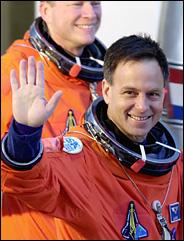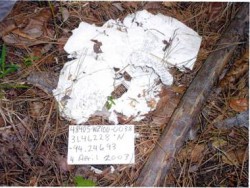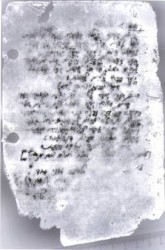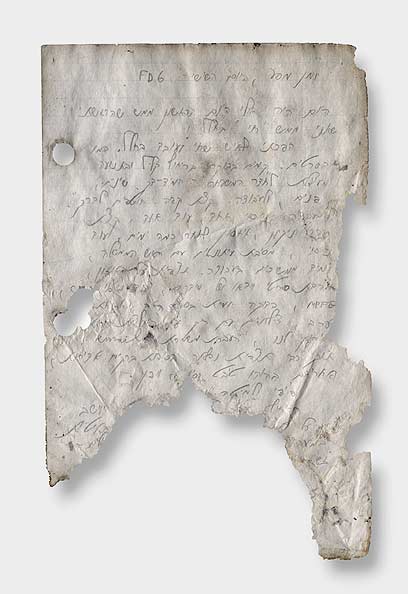[/caption]
Pages from an astronaut’s diary survived the explosion of the space shuttle Columbia in 2003, and on Sunday, selected pages went on display at a museum in Jerusalem. Israeli astronaut Ilan Ramon kept a personal diary during his time in orbit, and portions of it were found about two months after Columbia broke apart on February 1, 2003 while returning to Earth following the STS-107 mission. “Today was the first day that I felt that I am truly living in space. I have become a man who lives and works in space,” Ramon wrote in an entry on his sixth day in orbit.

37 pages survived the extreme heat of the explosion, as well as the 60 km (37-mile) fall to earth and several days of wet weather before they were found. “It’s almost a miracle that it survived — it’s incredible,” Israel Museum curator Yigal Zalmona said. “There is no rational explanation for how it was recovered when most of the shuttle was not.”

The pages were found in a field just outside of Palestine, Texas. On some pages, the writing was washed out, other pages were tattered and torn, pocked with irregular holes as if debris had ripped through them. Pieces were twisted into tightly crumpled wads smaller than a fingernail. Some pages were stuck tightly together and had to be delicately pried apart.
Once it had been verified that the pages were relevant to the Columbia debris, the papers were collected and given to Colonel Ramon’s family. Ramon’s wife, Rona, decided to bring the papers to Israel for deciphering the damaged writing and, ultimately, conservation of the torn and tattered pages.
Most of the pages contain personal information which Mrs. Ramon did not wish to make public. “We agreed to do the restoration completely respecting the family’s privacy and the sensitivity about how intimate the document is,” museum director James Snyder said.
The diary took about a year to restore, Zalmona said, and it took police scientists about four more years to decipher the pages. About 80 percent of the text has been deciphered, and the rest remains unreadable, he said.

Two pages will be displayed at the museum. One contains notes written by Ramon, and the other is a copy of the Kiddush prayer, a blessing over wine that Jews recite on the Sabbath. Zalmona said Ramon copied the prayer into his diary so he could recite it on the space shuttle and have the blessing broadcast to Earth.
There is no information available as to where the pages of the diary were situated during reentry, for example if they were in a pocket of Ramon’s spacesuit or in a padded, heat resistant container or simply held under his leg, as one astronaut suggested.
The diary provides no indication Ramon knew anything about potential problems on the shuttle. Columbia’s wing was gashed by a chunk of fuel tank foam insulation at liftoff and broke up just 16 minutes before it was scheduled to land at the Kennedy Space Center in Florida. All seven astronauts on board were killed.
The diary is being displayed as part of a larger exhibit of famous documents from Israel’s history, held to mark the country’s 60th anniversary this year.
Sources: Israel Ministry of Public Security, AP article


There was also a copy of a picture he took along with him, which was Petr Ginz’s “Moon Landscape”. Petr Ginz was murdered by my people, the German people, in 1944 in the Auschwitz concentration camp.
Despite he was not religious, he insisted on kosher food during his mission. Thus he wanted to express his connection to all Jews.
I hope I’m not remembered for handwriting that sloppy.
“There is no rational explanation for how it was recovered when most of the shuttle was not.”
I cringe when people use language like that. It’s implying that the survival of these pages was literally an act of god.
There IS a rational explanation for their recovery, and saying so doesn’t reduces their sentimental importance.
Looool @ “found in Palestine, Texas”… 🙂
RIP to all of them.
Very poigniant. At the risk of offending readers every space related death will have a huge impact on the public out of all proportion to what is the death of one person, or in this case seven, people. I think this is because space travel is still new and it is high visibility and it a still has the power to shock and stun us. Look how indifferent we are to the hundreds who die every day on roads across the globe. Even aeroplane crashes don’t seem to move us as they once did. Two hundred years down the line such accidents will merit only a few lines in a newpaper. I’d like to think it’s not because we’re becoming more callous but it’s just the way sh*t happens.
Jon Says,”I hope I’m not remembered for handwriting that sloppy”
I am not an supporter of Israel, but if that’s the best post that Jon can make about an exceptional person like Ramon best he keep it to himself.